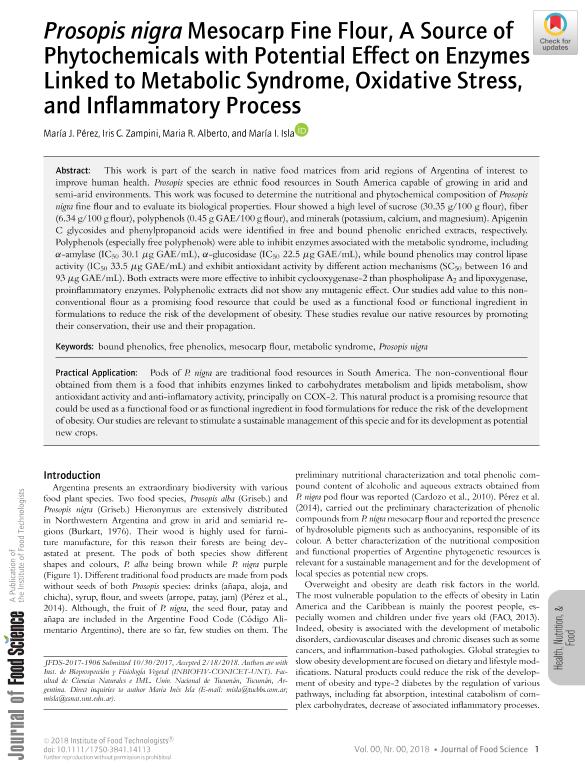Mostrar el registro sencillo del ítem
dc.contributor.author
Perez, Maria Jorgelina

dc.contributor.author
Zampini, Iris Catiana

dc.contributor.author
Alberto, Maria Rosa

dc.contributor.author
Isla, Maria Ines

dc.date.available
2019-10-10T15:15:20Z
dc.date.issued
2018-05
dc.identifier.citation
Perez, Maria Jorgelina; Zampini, Iris Catiana; Alberto, Maria Rosa; Isla, Maria Ines; Prosopis nigra mesocarp fine flour, A source of phytochemicals with potential effect on enzymes linked to metabolic syndrome, oxidative stress, and inflammatory process; Wiley Blackwell Publishing, Inc; Journal of Food Science; 83; 5; 5-2018; 1454-1462
dc.identifier.issn
0022-1147
dc.identifier.uri
http://hdl.handle.net/11336/85515
dc.description.abstract
This work is part of the search in native food matrices from arid regions of Argentina of interest to improve human health. Prosopis species are ethnic food resources in South America capable of growing in arid and semi-arid environments. This work was focused to determine the nutritional and phytochemical composition of Prosopis nigra fine flour and to evaluate its biological properties. Flour showed a high level of sucrose (30.35 g/100 g flour), fiber (6.34 g/100 g flour), polyphenols (0.45 g GAE/100 g flour), and minerals (potassium, calcium, and magnesium). Apigenin C glycosides and phenylpropanoid acids were identified in free and bound phenolic enriched extracts, respectively. Polyphenols (especially free polyphenols) were able to inhibit enzymes associated with the metabolic syndrome, including α-amylase (IC50 30.1 μg GAE/mL), α-glucosidase (IC50 22.5 μg GAE/mL), while bound phenolics may control lipase activity (IC50 33.5 μg GAE/mL) and exhibit antioxidant activity by different action mechanisms (SC50 between 16 and 93 μg GAE/mL). Both extracts were more effective to inhibit cyclooxygenase-2 than phospholipase A2 and lipoxygenase, proinflammatory enzymes. Polyphenolic extracts did not show any mutagenic effect. Our studies add value to this non-conventional flour as a promising food resource that could be used as a functional food or functional ingredient in formulations to reduce the risk of the development of obesity. These studies revalue our native resources by promoting their conservation, their use and their propagation. Practical Application: Pods of P. nigra are traditional food resources in South America. The non-conventional flour obtained from them is a food that inhibits enzymes linked to carbohydrates metabolism and lipids metabolism, show antioxidant activity and anti-inflamatory activity, principally on COX-2. This natural product is a promising resource that could be used as a functional food or as functional ingredient in food formulations for reduce the risk of the development of obesity. Our studies are relevant to stimulate a sustainable management of this specie and for its development as potential new crops.
dc.format
application/pdf
dc.language.iso
eng
dc.publisher
Wiley Blackwell Publishing, Inc

dc.rights
info:eu-repo/semantics/openAccess
dc.rights.uri
https://creativecommons.org/licenses/by-nc-sa/2.5/ar/
dc.subject
BOUND PHENOLICS
dc.subject
FREE PHENOLICS
dc.subject
MESOCARP FLOUR
dc.subject
METABOLIC SYNDROME
dc.subject
PROSOPIS NIGRA
dc.subject.classification
Otras Ciencias Biológicas

dc.subject.classification
Ciencias Biológicas

dc.subject.classification
CIENCIAS NATURALES Y EXACTAS

dc.title
Prosopis nigra mesocarp fine flour, A source of phytochemicals with potential effect on enzymes linked to metabolic syndrome, oxidative stress, and inflammatory process
dc.type
info:eu-repo/semantics/article
dc.type
info:ar-repo/semantics/artículo
dc.type
info:eu-repo/semantics/publishedVersion
dc.date.updated
2019-10-02T19:12:56Z
dc.journal.volume
83
dc.journal.number
5
dc.journal.pagination
1454-1462
dc.journal.pais
Reino Unido

dc.journal.ciudad
Londres
dc.description.fil
Fil: Perez, Maria Jorgelina. Universidad Nacional de Tucumán; Argentina. Consejo Nacional de Investigaciones Científicas y Técnicas. Centro Científico Tecnológico Conicet - Tucumán. Instituto de Química del Noroeste. Universidad Nacional de Tucumán. Facultad de Bioquímica, Química y Farmacia. Instituto de Química del Noroeste; Argentina
dc.description.fil
Fil: Zampini, Iris Catiana. Universidad Nacional de Tucumán; Argentina. Consejo Nacional de Investigaciones Científicas y Técnicas. Centro Científico Tecnológico Conicet - Tucumán. Instituto de Química del Noroeste. Universidad Nacional de Tucumán. Facultad de Bioquímica, Química y Farmacia. Instituto de Química del Noroeste; Argentina
dc.description.fil
Fil: Alberto, Maria Rosa. Universidad Nacional de Tucumán; Argentina. Consejo Nacional de Investigaciones Científicas y Técnicas. Centro Científico Tecnológico Conicet - Tucumán. Instituto de Química del Noroeste. Universidad Nacional de Tucumán. Facultad de Bioquímica, Química y Farmacia. Instituto de Química del Noroeste; Argentina
dc.description.fil
Fil: Isla, Maria Ines. Universidad Nacional de Tucumán; Argentina. Consejo Nacional de Investigaciones Científicas y Técnicas. Centro Científico Tecnológico Conicet - Tucumán. Instituto de Química del Noroeste. Universidad Nacional de Tucumán. Facultad de Bioquímica, Química y Farmacia. Instituto de Química del Noroeste; Argentina
dc.journal.title
Journal of Food Science

dc.relation.alternativeid
info:eu-repo/semantics/altIdentifier/url/http://doi.wiley.com/10.1111/1750-3841.14113
dc.relation.alternativeid
info:eu-repo/semantics/altIdentifier/doi/https://dx.doi.org/10.1111/1750-3841.14113
Archivos asociados
